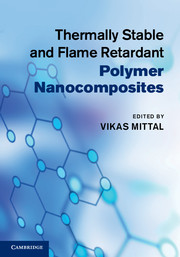Book contents
- Frontmatter
- Contents
- Contributors
- Preface
- Part I Thermal stability
- Part II Flame retardancy
- 7 Introduction to flame retardancy of polymer–clay nanocomposites
- 8 Flame retardant nanocomposites with polymer blends
- 9 Flame retardancy of polyamide/clay nanocomposites
- 10 Self-extinguishing polymer–clay nanocomposites
- 11 Flame retardant polymer nanocomposites with fullerenes as filler
- 12 Flame retardant polymer nanocomposites with alumina as filler
- 13 Polymer/layered double hydroxide flame retardant nanocomposites
- 14 Flame retardant SBS–clay nanocomposites
- Index
- References
7 - Introduction to flame retardancy of polymer–clay nanocomposites
from Part II - Flame retardancy
Published online by Cambridge University Press: 05 August 2011
- Frontmatter
- Contents
- Contributors
- Preface
- Part I Thermal stability
- Part II Flame retardancy
- 7 Introduction to flame retardancy of polymer–clay nanocomposites
- 8 Flame retardant nanocomposites with polymer blends
- 9 Flame retardancy of polyamide/clay nanocomposites
- 10 Self-extinguishing polymer–clay nanocomposites
- 11 Flame retardant polymer nanocomposites with fullerenes as filler
- 12 Flame retardant polymer nanocomposites with alumina as filler
- 13 Polymer/layered double hydroxide flame retardant nanocomposites
- 14 Flame retardant SBS–clay nanocomposites
- Index
- References
Summary
Introduction
The use of plastic materials, from construction materials to consumer electronics, has been increasing substantially in the past few decades. Easy processing, low density, and possible recycling make plastic the first choice of materials for many applications, such as automobile parts and food packaging structures. Comparing with traditional materials such as metal and concrete, plastic materials are combustible in a fire. Enhancing the flame retardation of plastic materials has been a priority in material development for many researchers. Many fire retardation standards have been established for relevant industries. Several trade organizations have also created industrial standards for fire safety standards and testing procedures. Underwriters Laboratories (UL) is an independent product safety certification organization that has been testing products and writing standards for safety for more than a century. UL has extensive standards and testing protocols for building materials, energy, lighting, power, and control, as well as wire and cables. The International Electrotechnical Commission (IEC) also publishes extensive standards for materials used in the electrical and electronic industries.
- Type
- Chapter
- Information
- Thermally Stable and Flame Retardant Polymer Nanocomposites , pp. 161 - 185Publisher: Cambridge University PressPrint publication year: 2011
References
- 4
- Cited by

